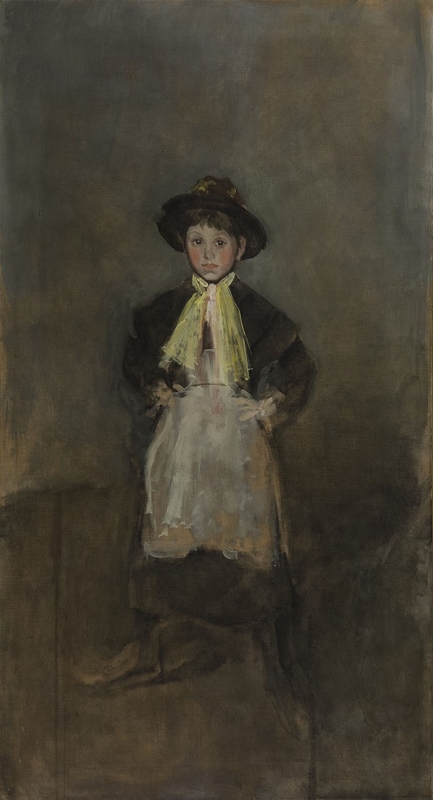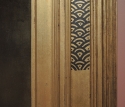Technique
The background was thinly painted in shades of grey and brown. The space is not clearly defined. There are numerous pentimenti, suggesting the figure was moved: the hat was originally further to right, and her right arm, perhaps further down and to left. The final position of her left foot is unclear, and the right foot is blurred, merging into the floor. Other pentimenti suggest that a larger figure was originally painted, and rubbed out, while vertical lines to left and right of the girl do not appear to relate to the composition at all. By contrast, the face and coat were painted quite carefully, before the addition of the vivid, slashing, almost dry-brush strokes of pale pink, white, and pale yellow that convey the apron and scarf.
Whistler explained, or complained, in 1893, about the exhibition of The Chelsea Girl in Chicago:
'They have ... put prominently to the fore the girl (my present to Mr Cassatt) as though such were my completed work - sent by me as a representative finished picture! -
Whereas it is the sketch of one afternoon - or rather the first statement or beginning of a painting - I am not excusing it mind - of course it is a damn fine thing - only I should certainly never have proposed to send it to the Chicago place for the hordes of foolish people to look upon!' 1
In 2015 the Crystal Bridges Museum of American Art commented:
'The Chelsea Girl is representative of Whistler’s mature painting style, featuring a single, monumental figure rendered in a limited color palette. … the subject of this portrait is a working-class girl. Whistler dignifies the girl with a defiant stance and pointed gaze and depicts her using a few vigorous brushstrokes. Although parts of the painting remain seemingly unfinished, it was celebrated by critics when it was exhibited in 1893.
… Because of its sketchy style, Whistler’s working methods are visible in the painting. He used thin glazes of brown paint for the shoulders of the girl’s coat, layers of peach and rose for her face, thick yellow brushstrokes to render her scarf, and dashes of white to fill in the apron.' 2
Denys Sutton compared the 'bolder handling' to that of Frans Hals (1652/1653-1666), which Whistler is known to have admired. 3
Conservation History
Unknown.
Frame
The picture as framed by 1904 is seen in the exhibition photographs reproduced above.
The current Flat Whistler frame bears carefully painted cloud or feather patterns and a highly decorative butterfly signature. 4 These painted decorations are unusually precise and may have been painted to Whistler's instructions or based on his designs.
Notes:
1: Whistler to E. G. Kennedy, [21 September 1893], GUW #09710.
2: 'Crystal Bridges announces acquisitions spanning 19th century to contemporary American art: From an iconic work by James McNeill Whistler to a site-specific commission by Maya Lin', 11 September 2015, website at https://crystalbridges.org/blog.
3: Sutton 1963 [more] , p. 104.
4: Dr S. L. Parkerson Day, Report on frames, 2017.
Last updated: 4th June 2021 by Margaret















